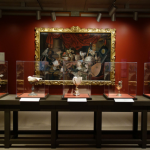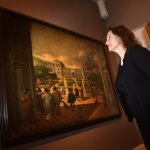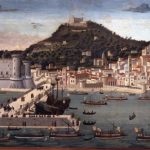The exhibition on the painting and collections of the Paston family held in Norwich Castle Museum over the summer, was a long-awaited moment for all those interested in 17th-century collecting or more particularly, in the cabinet of curiosity. The painting of the Paston Treasure was known, but not very well and was full of unresolved questions, including when it was painted, by whom or indeed why. The exhibition has brought the painting the attention it deserves, and although many questions remain, some, such as the dating and the commission seem closer to being resolved.
As a result of extensive research, it is now suggested that the painting was probably commissioned by William (1610-1663), rather than his son Robert as previously thought. William has been shown to have had a most fascinating history, including a long tour to Italy certainly and most probably through the Hapsburg domains to Schloss Ambras near Innsbruck, possibly to Prague and certainly to the Egypt. His treasures, many of them included in the painting, reflected the objects that he would have seen, both at Ambras and in Florence. In Florence, he visited the Grand ducal collections with the artist and sculptor, Nicholas Stone, another link between this merchant and the international world of art collectors.
The exhibition brought together many of actual objects displayed in the painting, as well as examples of the types listed in the 1673 inventory of Oxnead Hall, demonstrating the rich and very continental taste and commissions of the owner. New discoveries abounded, such as those resulting from the technical investigations, which confirmed the changes and repainting of some sections, thought to come from the intervention of the patron. A painting of Oxted Hall was on display, which had been the subject of a recent article by Simon Jervis in the Burlington Magazine about the architectural framework for the building of Oxnead Hall; the section of the exhibition on the Paxtons and alchemy took the visitor into the scientific world of Sir Thomas Browne in Norfolk to the manuscript by Margaret Paston (1652-1723) of alchemical recipes c1683. Married to a Venetian and exchanging information with the princes of Europe, her life demands more investigation.
The commission for the painting remains extraordinary both in terms of subject and artist. Clearly painted by an artist of considerable skill, we cannot determine who he was, except that he was probably either Dutch or Flemish, and possibly was visiting England rather than a resident. The wealth of detail in the painting led the curators of the exhibition and our guides. Andrew Moore and Francesca Vanke, to argue that the painter must have visited Oxnead Hall and painted the objects in situ.
With such a plethora of art works and historical context, it is no wonder that the members of the Society for the History of Collecting happily spent many hours in the exhibition, led through all the intrigues and insights into the cultural ambience of England in the middle of the seventeenth century. There is not space here to go into all the many aspects of the exhibition: the patrons, family, travel, artistic milieu, architecture, works of art, history of science, politics all played a role and took their part in this fascinating exhibition. The members of the Society who were able to take part in the visit were privileged to be able to delve into some of these questions through the generosity of Andrew and Francesca. We are enormously grateful to them for giving up the whole of their Saturday to us and offering us such a rewarding visit.
Adriana Turpin



